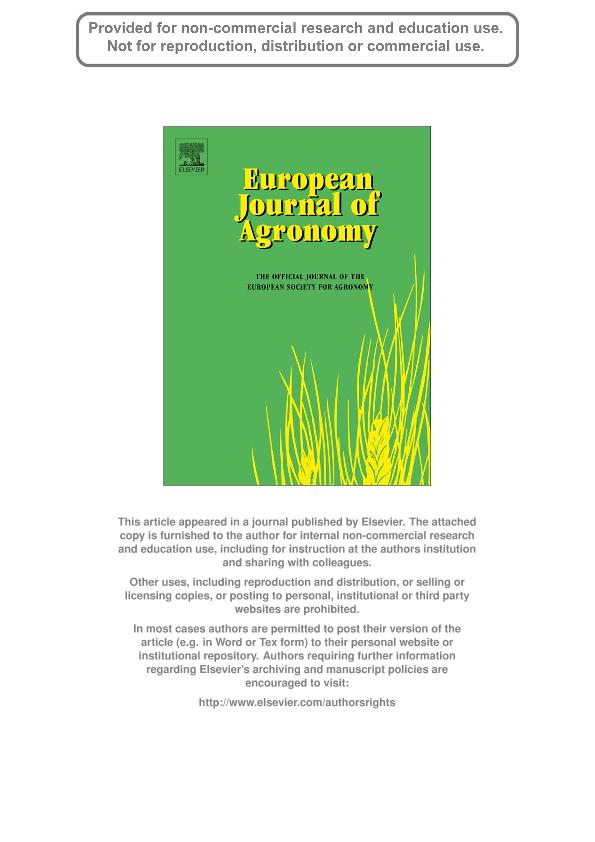Mostrar el registro sencillo del ítem
dc.contributor.author
Takashima, Nicolás E.
dc.contributor.author
Rondanini, Deborah Paola

dc.contributor.author
Puhl, Laura E.
dc.contributor.author
Miralles, Daniel Julio

dc.date.available
2017-06-02T19:04:36Z
dc.date.issued
2013-07
dc.identifier.citation
Takashima, Nicolás E.; Rondanini, Deborah Paola; Puhl, Laura E.; Miralles, Daniel Julio; Environmental factors affecting yield variability in spring and winter rapeseed genotypes cultivated in the southeastern Argentine Pampas; Elsevier Science; European Journal Of Agronomy; 48; 7-2013; 88-100
dc.identifier.issn
1161-0301
dc.identifier.uri
http://hdl.handle.net/11336/17393
dc.description.abstract
Rapeseed yields in Argentina are low (averaging 1400 kg/ha nationwide) with a high inter-annual variability. One of the limiting factors for improving yields is the lack of information on the adaptability of the cultivars, especially in the main rapeseed-producing area, the southeastern Pampas. The objectives of this study were to (i) quantify and analyze the yield variability of winter and spring rapeseed hybrids introduced in Argentina, (ii) identify the main environmental factors that affect the yields of the spring and winter genotypes in the southeastern Pampas, and (iii) model and validate rapeseed yields from environmental variables in the pre- and post-flowering periods. Principal component analysis (PCA) and linear regression methods were used to analyze 129 data points from 16 comparative yield trials in eight sites of southeastern Pampas. The rainfed crops were sown between April and July and from 2007 to 2009. Pre- and post-flowering phases were recorded in each experiment; temperature, frost occurrences, rainfall and radiation were measured during each phase. Yield variability (600–3700 kg ha−1) was slightly lower in spring than in winter genotypes (CV 0.25 versus 0.38). Sixty percent of the winter genotype variability was explained by the first axis which was associated to the pre- and post-flowering durations, while 25% of the variability was explained by the second axis associated to yield. Almost 50% of the spring genotype variability was explained by the first axis associated to pre-flowering and total durations, while 27% of the variability was explained by the second axis in which post-flowering duration was associated to yield. Winter genotypes evidenced vernalization requirements that were either partially or not fulfilled, so, the longer the photoperiod, the longer the pre-flowering phase duration. In the critical period of 30 d post-flowering, yield was not associated to the photothermal quotient. In winter genotypes, yield was associated to a linear model which included rainfall during the crop cycle, radiation and pre-flowering temperatures (R2 = 0.50). The model was adequately validated with independent data (n = 116) from official trials. For spring genotypes, only the frost occurrences during the critical period were relevant (R2 = 0.26) and placing the flowering time after October decreased the risk of late frost damage. Water use efficiency (WUE) values ranged from 1.6 to 6.7 kg ha−1 per mm of rain without a clear trend between spring and winter genotypes for this trait. In conclusion, winter genotypes did not necessarily yield more than the spring materials. In addition, rainfall during the crop cycle and frost occurrences during flowering were the main limiting factors of the winter and spring genotype yields, respectively, in the southeastern Pampas.
dc.format
application/pdf
dc.language.iso
eng
dc.publisher
Elsevier Science

dc.rights
info:eu-repo/semantics/openAccess
dc.rights.uri
https://creativecommons.org/licenses/by-nc-nd/2.5/ar/
dc.subject
Rapeseed
dc.subject
Genotype
dc.subject
Environment
dc.subject.classification
Agricultura

dc.subject.classification
Agricultura, Silvicultura y Pesca

dc.subject.classification
CIENCIAS AGRÍCOLAS

dc.title
Environmental factors affecting yield variability in spring and winter rapeseed genotypes cultivated in the southeastern Argentine Pampas
dc.type
info:eu-repo/semantics/article
dc.type
info:ar-repo/semantics/artículo
dc.type
info:eu-repo/semantics/publishedVersion
dc.date.updated
2017-06-02T17:31:12Z
dc.journal.volume
48
dc.journal.pagination
88-100
dc.journal.pais
Países Bajos

dc.journal.ciudad
Amsterdam
dc.description.fil
Fil: Takashima, Nicolás E.. Syngenta Agro; Argentina
dc.description.fil
Fil: Rondanini, Deborah Paola. Universidad de Buenos Aires. Facultad de Agronomia; Argentina. Consejo Nacional de Investigaciones Científicas y Técnicas; Argentina
dc.description.fil
Fil: Puhl, Laura E.. Universidad de Buenos Aires. Facultad de Agronomía. Departamento de Métodos Cuantitativos y Sistemas de Información; Argentina
dc.description.fil
Fil: Miralles, Daniel Julio. Consejo Nacional de Investigaciones Científicas y Técnicas. Oficina de Coordinación Administrativa Parque Centenario. Instituto de Investigaciones Fisiológicas y Ecológicas Vinculadas a la Agricultura. Universidad de Buenos Aires. Facultad de Agronomía. Instituto de Investigaciones Fisiológicas y Ecológicas Vinculadas a la Agricultura; Argentina
dc.journal.title
European Journal Of Agronomy

dc.relation.alternativeid
info:eu-repo/semantics/altIdentifier/doi/http://dx.doi.org/10.1016/j.eja.2013.01.008
dc.relation.alternativeid
info:eu-repo/semantics/altIdentifier/url/http://www.sciencedirect.com/science/article/pii/S1161030113000099
Archivos asociados
